Layered vegetation creates effective natural screens by combining plants of different heights. Start with tall canopy trees (15-30 feet) as your backdrop, add mid-height shrubs (6-15 feet) for the middle layer, and finish with groundcovers (1-5 feet) for the foundation. This three-tier approach provides privacy while supporting wildlife and adding seasonal interest. You’ll create a living wall that’s both functional and beautiful—combine evergreens with deciduous plants for year-round coverage that transforms your landscape.
Layered Vegetation Heights For Natural Screens

When planning your landscape design, layered vegetation heights offer an elegant solution for creating natural screens that combine both form and function. This strategic arrangement places taller plants like evergreen trees at the back, gradually shifting to shorter varieties in the foreground.
For year-round privacy screens, incorporate evergreens such as Thuja or Holly as your tallest layer. These provide consistent coverage while effectively blocking unwanted views and reducing noise.
Plant evergreens like Thuja and Holly to maintain privacy year-round while naturally muffling sound and obscuring unwanted sightlines.
Mid-height plants like ornamental trees and magnolias create a seamless shift between tall and low elements, adding seasonal interest with their blooms and textures.
Complete your layered planting with groundcovers and ornamental grasses at the lowest level. Choosing native plants for your screen guarantees resilience against local pests while supporting wildlife and creating a visually interesting, ecologically sound landscape.
Understanding the Three-Tier Approach to Privacy Plantings
The three-tier approach to privacy plantings offers you distinct vertical layering benefits by combining tall trees, mid-height shrubs, and low groundcovers in a single, cohesive screen.
You’ll create a more natural-looking barrier when plants of varying heights work together, mimicking woodland edges where complementary growth patterns naturally occur.
Your privacy screen will develop faster and more effectively when you select plants that grow at different rates but ultimately support each other’s development through shared resources and protection.
Vertical Layering Benefits
Privacy planting achieves its maximum effectiveness through thoughtful vertical layering, which transforms simple barriers into dynamic living walls. The vertical layering technique not only enhances your privacy screen but creates visual interest throughout the seasons. By incorporating plants of different heights, you’ll establish a natural-looking boundary that serves multiple purposes beyond simple screening.
| Layer | Plant Types | Benefits |
|---|---|---|
| Top | Tall evergreen trees | Year-round backdrop, noise reduction |
| Middle | Medium shrubs | Changing screening, wildlife habitat |
| Bottom | Groundcovers, grasses | Visual completion, soil protection |
Your layered approach supports local wildlife by providing diverse habitats while reducing maintenance needs. As seasons change, each tier contributes unique textures and colors, ensuring your privacy barrier remains both functional and beautiful throughout the year.
Complementary Growth Patterns
Creating a truly effective privacy screen requires mastering the three-tier approach, where each plant works in harmony with those around it. When you select plants for each tier—tall trees at the back, medium shrubs in the middle, and low groundcovers in front—you’re establishing a relationship that maximizes privacy screening while maintaining aesthetic appeal.
The key to successful layering technique lies in understanding how different plants complement each other’s growth habits. Combining evergreen and deciduous varieties guarantees year-round coverage while introducing seasonal changes and visual interest.
Native plants work particularly well in this system, as they’ve evolved together and naturally support local wildlife ecosystems.
Remember to account for mature sizes when planning your tiers. Proper spacing prevents future overcrowding and maintains the distinct layers that make this approach so effective for creating natural, breathable privacy barriers.
Selecting Canopy Trees for the Backdrop Layer (15-30 Feet)
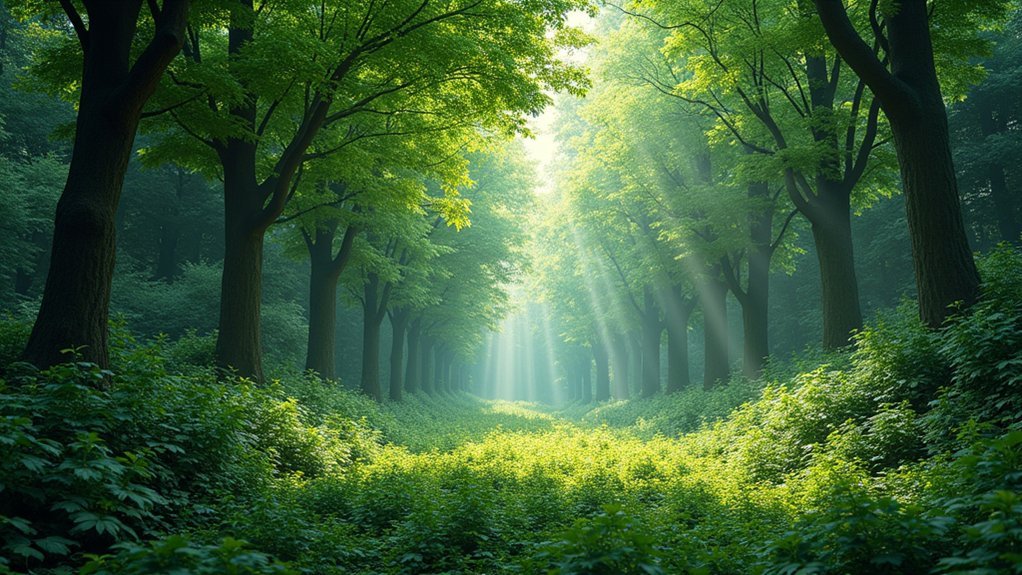
Canopy trees reaching 15-30 feet establish the foundational backdrop for your layered landscape, with varieties like Red Maple and Eastern Redbud offering both height and seasonal interest.
You’ll want to reflect on each species’ growth rate and mature size, as fast-growers like Silver Maple provide quicker privacy while others develop more gradually.
Whenever possible, select native species such as Serviceberry or Sweetgum that not only adapt well to local soil conditions but also support regional wildlife and ecological balance.
Tallest Trees Create Foundation
The foundation of any layered landscape begins with selecting the right backdrop trees. Your tallest trees, reaching 15-30 feet, create the essential framework for visual screening and privacy. When planting these canopy trees, guarantee proper planting depth to promote healthy root development.
| Tree Variety | Height | Width | Light Needs |
|---|---|---|---|
| Nellie Stevens Holly | 15-25 ft | 8-12 ft | Full sun to part shade |
| Little Gem Magnolia | 15-20 ft | 8-10 ft | Full sun |
| Thuja Green Giant | 20-30 ft | 15-20 ft | Full sun to part shade |
| Cryptomeria Radicans | 20-25 ft | 10-15 ft | Full sun |
Select varieties that grow at medium to fast rates for quicker establishment. These majestic backdrop specimens not only provide privacy but add seasonal interest with their distinctive foliage and flowers.
Consider Growth Patterns
When selecting ideal canopy trees for your backdrop layer, understanding their growth patterns becomes essential for long-term landscape success. Choose species that reach 15-30 feet—like Holly trees that grow to 30-40 feet or Magnolias at 20-25 feet—to form the perfect privacy screen foundation.
Pay attention to growth rates when planning your landscape design. Fast-growing varieties like Thuja (Arborvitae) and Japanese Cedar establish quickly, providing more immediate screening benefits.
Position these canopy trees strategically to maximize their height advantage and enhance privacy.
For year-round effectiveness, incorporate both evergreen and deciduous canopy trees in your backdrop. This thoughtful mixture not only maintains privacy throughout seasons but also adds visual interest as your landscape evolves through the year, creating a dynamic yet functional screen.
Native Species Priority
Prioritizing native species for your backdrop layer offers multiple advantages beyond just creating an effective privacy screen.
Choose canopy trees like oak (Quercus spp.) and red maple (Acer rubrum) that naturally grow to 15-30 feet tall to establish a robust backdrop that thrives in your local conditions.
These native species enhance biodiversity by providing essential food and shelter for local birds and insects.
You’ll find they require less maintenance than non-natives while demonstrating superior adaptability to regional weather patterns and soil conditions.
When selecting your canopy trees, remember they’re crucial contributors to ecological balance in your landscape.
They’ll resist local pests and diseases more effectively while creating sustainable habitat connections.
Plan carefully for their mature spread to prevent overcrowding with other vegetation layers as your natural screen develops.
Mid-Height Shrubs and Small Trees for the Middle Layer (6-15 Feet)
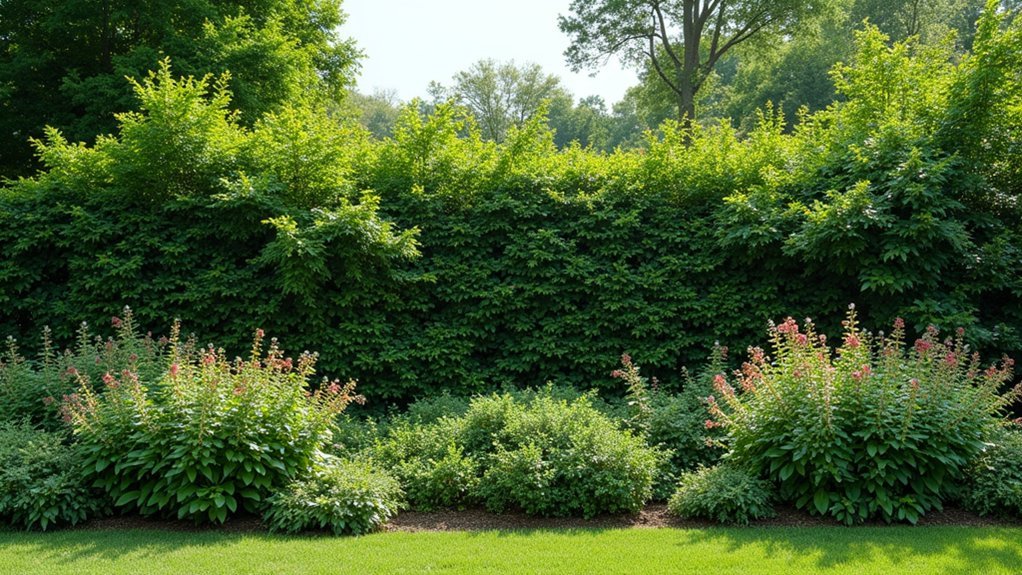
Creating depth and visual interest in your landscape requires strategic use of mid-height shrubs and small trees that reach 6-15 feet tall. Plants like American holly and compact magnolia varieties serve as the perfect middle layer in your privacy screen, connecting the gap between taller trees and groundcovers.
When selecting mid-height shrubs, consider their adaptability to your local conditions. Boxwood and chokeberry provide excellent functionality while adding year-round appeal through distinctive foliage and seasonal flowers.
Remember to space your plantings appropriately to guarantee proper air circulation, which prevents disease and promotes healthy growth.
Proper plant spacing ensures healthy air circulation, creating a disease-resistant landscape that thrives season after season.
This intermediate layer not only blocks unwanted sightlines and reduces noise but also creates a cohesive, layered appearance that feels natural and inviting in your landscape design.
Groundcover and Low-Growing Plants for the Foundation Layer (1-5 Feet)
The foundation layer of your layered landscape delivers essential functionality while completing your privacy screen design. Low-growing plants ranging from 1-5 feet create a seamless shift between taller elements while suppressing weeds and improving soil health.
| Plant Type | Height Range | Benefits |
|---|---|---|
| Creeping Thyme | 1-2 feet | Weed suppression, fragrance |
| Blue Fescue | 1-3 feet | Texture, drought tolerance |
| Black-eyed Susans | 2-4 feet | Pollinator attraction, color |
| Daylilies | 2-4 feet | Low maintenance, vibrant blooms |
| Native Groundcovers | 1-5 feet | Local adaptability, wildlife support |
For maximum visual interest, incorporate ornamental grasses around taller plants. They’ll add movement and texture while creating cohesive design. Native groundcovers guarantee your foundation layer thrives with minimal maintenance, providing vital support to your overall privacy screen strategy.
Seasonal Considerations for Year-Round Privacy Effectiveness
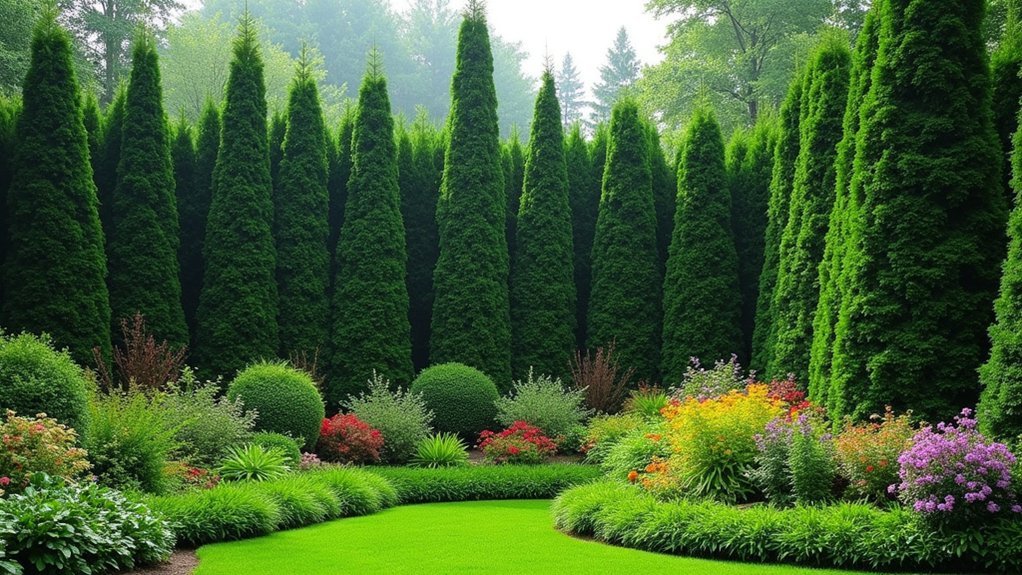
While your foundation layer establishes the base structure of your privacy screen, seasonal changes present ongoing challenges for maintaining effective coverage.
Combining evergreen and deciduous plants guarantees privacy doesn’t disappear with winter’s arrival. Position taller evergreens at the back to block sightlines year-round, then layer with deciduous shrubs that provide summer density and fall color.
Strategic layering of evergreens and deciduous plants ensures year-round privacy while maximizing seasonal beauty.
Incorporate seasonal flowering plants strategically to maintain visual interest without compromising privacy. Understanding growth patterns helps you anticipate and prevent seasonal gaps in your screen.
Remember that deciduous plants offer summer fullness but winter transparency, requiring evergreen backup.
Regular pruning maintains your privacy screens at ideal heights and density throughout the year.
Frequently Asked Questions
What Is the Best Tall Plant for Screening?
For screening, you’ll find Thuja (Arborvitae) most effective as it grows 30-40 feet tall with dense foliage. Holly, Magnolia, Japanese Cedar, and Spruce are excellent alternatives offering various heights and visual interest.
What Is the Rule of 3 in Landscaping?
The rule of 3 in landscaping means you’ll group plants or elements in threes to create visual harmony. You’re creating rhythm through repetition while ensuring your garden feels balanced, cohesive, and naturally appealing to the eye.
How Do You Layer Plants for Privacy?
To layer plants for privacy, start with tall evergreens at the back, add mid-height shrubs in the middle, and finish with ornamental grasses in front. You’ll want at least five diverse plant layers for year-round coverage.
What Grows Tall and Fast for Privacy?
For fast, tall privacy, you’ll get excellent results with Thuja Green Giant, Japanese Cedar, or Norway Spruce. These evergreens grow quickly, reaching 30-40 feet, and provide dense screening year-round in most temperate zones.
In Summary
As you design your natural privacy screen, remember that thoughtful layering creates both depth and functionality. By combining tall canopy trees, mid-height shrubs, and low-growing foundation plants, you’ll establish a living barrier that’s beautiful in every season. Don’t forget to take into account your climate, available space, and maintenance preferences. With the right plant combinations, you’ll create a private, vibrant outdoor sanctuary you’ll enjoy for years.
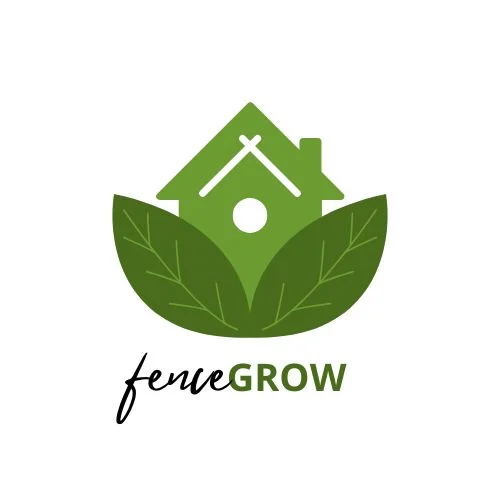

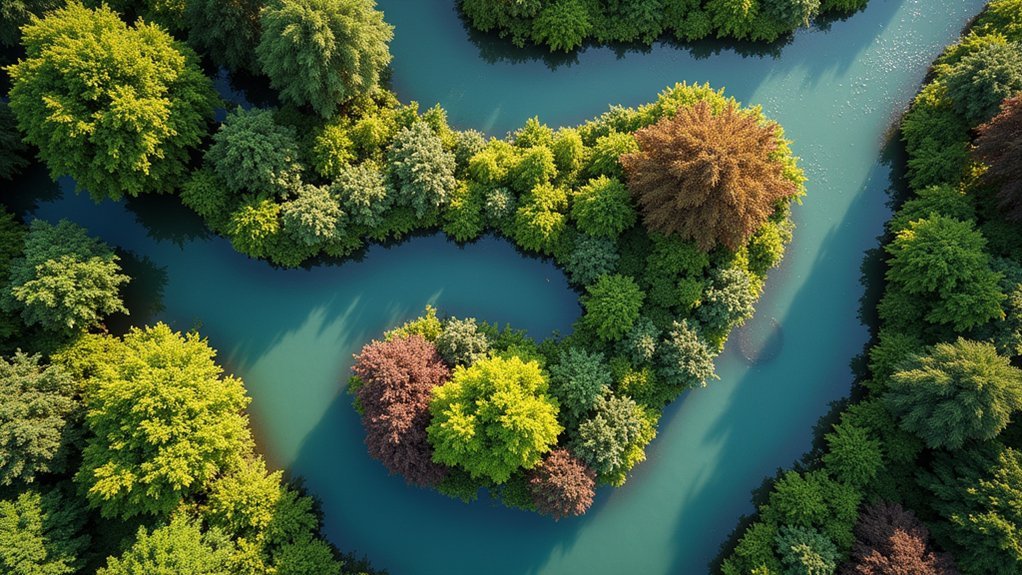
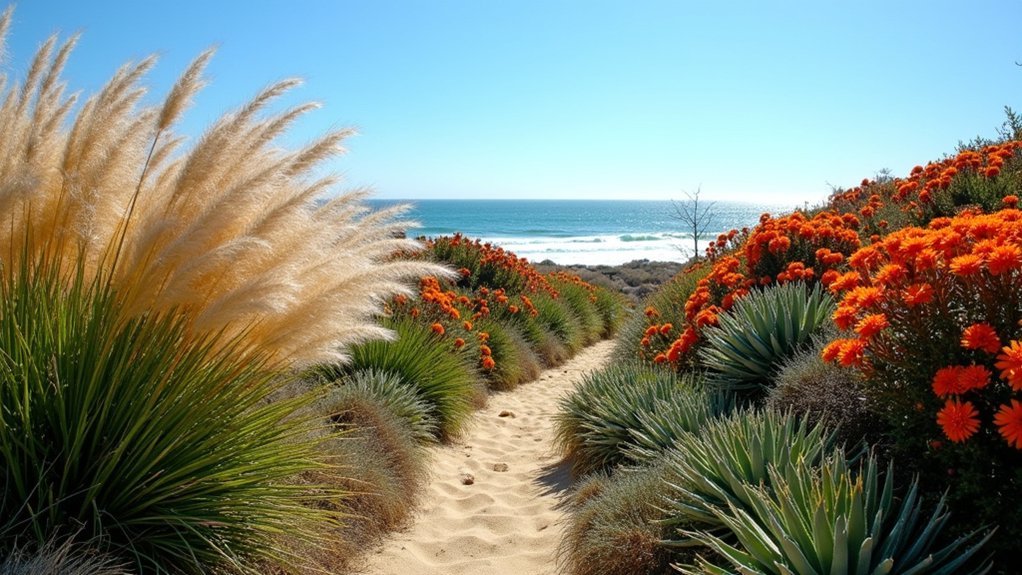
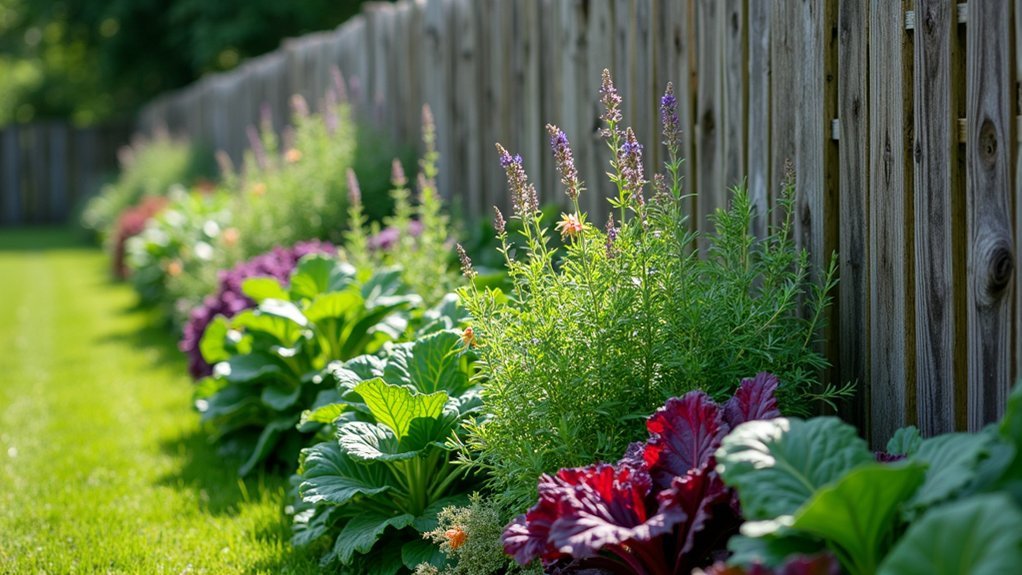
Leave a Reply